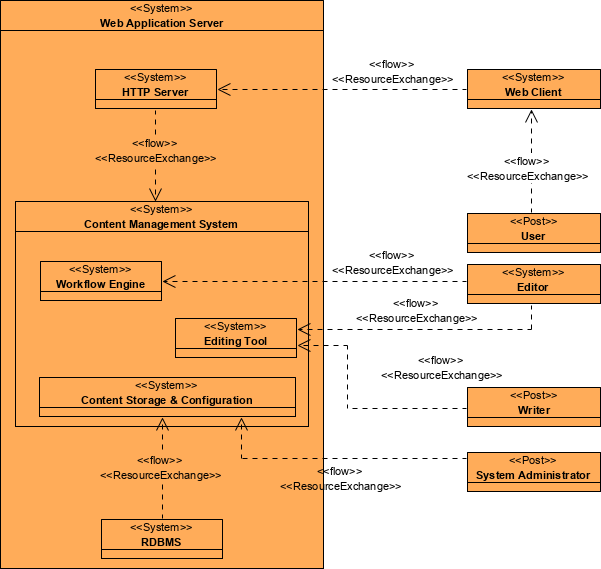An SV-1 specifies the composition and interaction of resources.
The SV-1 links together the operational and systems architecture views by depicting how resources are structured and how they interact in order to realise the logical architecture specified in an OV-2, Operational Node Relationship Description. An SV-1 may represent the realisation of a requirement specified in an OV-2 (i.e. in a to-be architecture) and, consequently, there may be many alternative SV suites that provide candidate solutions that realise the operational requirement.
The SV-1 depicts interactions between resources. A resource interaction is a simplified representation of a pathway or network, usually depicted graphically as a connector (i.e. a line that can be labelled with supporting information). Note that interactions between systems (Artefacts used as systems) may be further specified in detail in the SV-2, Systems Communications Description series, and SV-6, Systems Data Exchange Matrix.
Resources may be decomposed in SV-1 to any level (i.e. depth) that the architect sees fit. When one resource is part of another, the architect must specify the context in which the part is used.
Usage
The intended usage of the SV-1 includes:
- Solution specification.
- Definition of solution options.
- System Requirements specification.
- Interface requirements capture.
- Capability integration planning.
- System integration management.
- Operational planning (capability configuration definition).
Product Description
The primary purpose of an SV-1 is to show resource structure; i.e. to identify the primary subsystems, posts and roles and their interactions. SV-1 contributes to user understanding of the structural characteristics of the capability. Resource structures may be identified in SV-1 to any level (i.e. depth) of decomposition the architect sees fit. An SV-1 may be adorned with nodes originally specified in OV-2. In this way, traceability can be established from the logical OV structure to the physical SV structure.
In its simplest form, an SV-1 can be used to depict systems and sub-systems, and identify the interfaces between them; however, this rarely adds more to that which can be shown in an SV-2, product. The real benefit of an SV-1 is its ability to show the human aspects of an individual architecture, and how these interact with systems. In addition, MODAF has the concept of a ‘capability configuration’ which is used to gather together systems, assets and people into a configuration which can meet a specific capability.
If possible, an SV-1 will show resources and their interactions for the entire architecture on the same diagram. If a single SV-1 is not possible, the structure should be decomposed into multiple SV-1s.
Creating a Resource Interaction Specification diagram
To create a Resource Interaction Specification (diagram):
- Click on Resource Interaction Specification in the Action Artifact area, and then select Create New Diagram.
- Type the diagram name and press Enter.
- A blank diagram is created and you can start constructing the view.
- Draw the resource types – ResourceArchitecture / System / CapabilityConfiguration / Organization / Person / Post / Responsibility / Project / NaturalResource / ResourceArtifact / Software / Technology.
- Draw the resource flows among the resource types by creating ResourceExchanges / Commands / Controls between them.

MODAF in Visual Paradigm
The MODAF is brought to you by Visual Paradigm, a full-featured development platform. Visual Paradigm provides an easy-to-use, model-driven MODAF tool that supports the development of MODAF views and models. You can create integrated MODAF products and generate architectural documents that facilitate organizations to efficiently coordinate enterprise architecture initiatives.